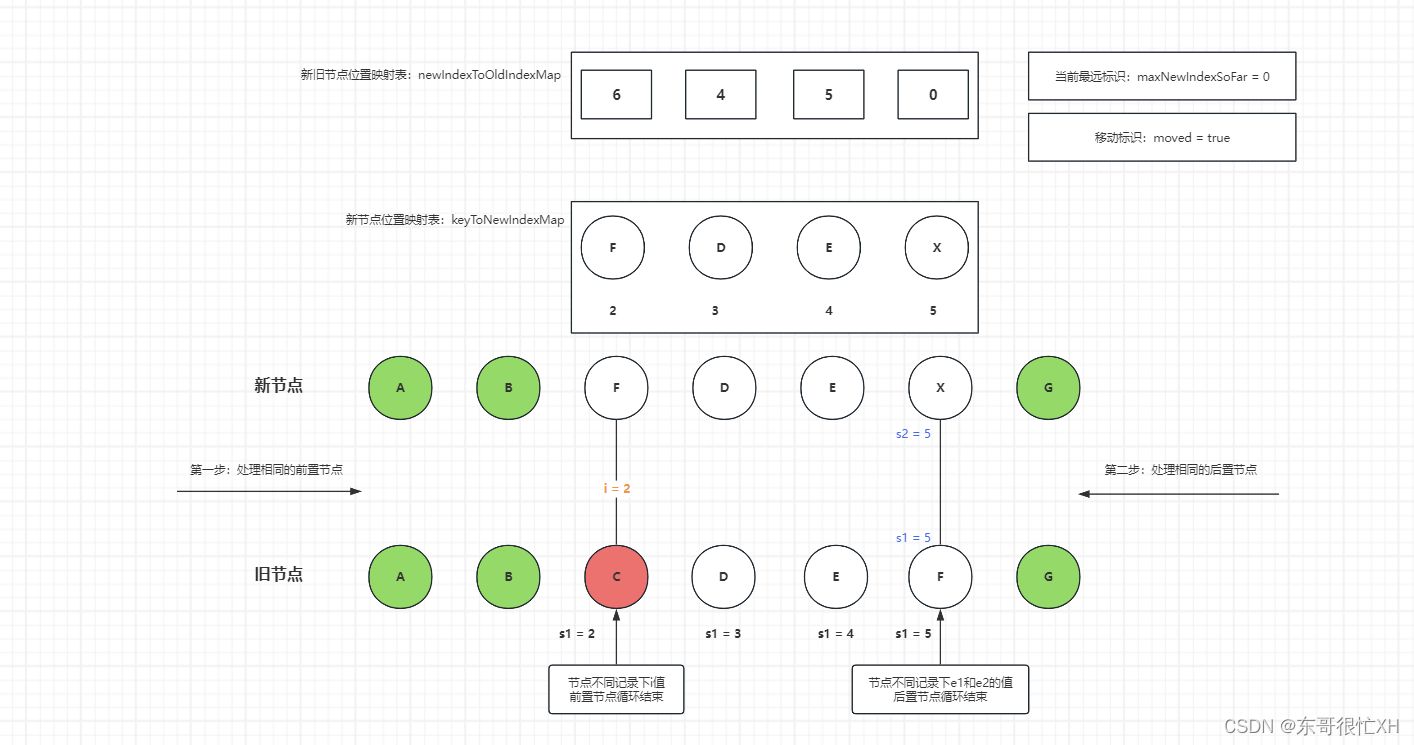Vue 3 的 diff 算法相较于 Vue 2 有了一些改进和优化,主要是为了应对更复杂的组件结构和更高的性能需求。
以下是 Vue 3 diff 算法在处理列表更新时的大致步骤:
-
头头比较:首先,比较新旧列表的头节点(即第一个节点)。如果它们相同(基于 key 判断),则复用该节点,并移动两个列表的头指针到下一个节点。
-
尾尾比较:然后,比较新旧列表的尾节点(即最后一个节点)。如果它们相同,也复用该节点,并移动两个列表的尾指针到前一个节点。
-
移动或创建节点:如果头头比较和尾尾比较都没有找到可复用的节点,Vue 会尝试在旧列表中查找与新节点匹配的节点。如果找到了,则移动该节点到正确的位置;如果没有找到,则创建一个新节点。
-
删除节点:最后,检查旧列表中是否有剩余的节点没有被复用或移动。如果有,说明这些节点在新列表中不再需要,因此将它们从 DOM 中删除。
前置节点后置节点比对:

前置节点(头头比较):
比较新旧列表的头节点(即第一个节点)。如果它们相同(基于 key 判断),则复用该节点,并移动两个列表的头指针到下一个节点。
// 1. sync from start
// (a b) c
// (a b) d e
// 处理相同的前置节点
while (i <= e1 && i <= e2) {
// 获取索引为 i 的 新老节点 n1 和 n2
const n1 = c1[i]
const n2 = (c2[i] = optimized
? cloneIfMounted(c2[i] as VNode)
: normalizeVNode(c2[i]))
// 判断n1和n2新老节点相同的话,进行节点的更新操作
if (isSameVNodeType(n1, n2)) {
patch(
n1,
n2,
container,
null,
parentComponent,
parentSuspense,
namespace,
slotScopeIds,
optimized,
)
} else {
// n1 和 n2 不是相同节点话,前置节点的处理结束
break
}
// 循环比对下一对前置节点
i++
}后置节点(尾尾比较):
比较新旧列表的尾节点(即最后一个节点)。如果它们相同,也复用该节点,并移动两个列表的尾指针到前一个节点。
// 2. sync from end
// a (b c)
// d e (b c)
// 处理相同的后置节点
while (i <= e1 && i <= e2) {
// 从最后的节点开始查找,获取的相关节点n1 和 n2
const n1 = c1[e1]
const n2 = (c2[e2] = optimized
? cloneIfMounted(c2[e2] as VNode)
: normalizeVNode(c2[e2]))
// 如果 n1 和 n2 是相同类型节点的话,则进行节点的更新操作
if (isSameVNodeType(n1, n2)) {
patch(
n1,
n2,
container,
null,
parentComponent,
parentSuspense,
namespace,
slotScopeIds,
optimized,
)
} else {
// 当n1 和 n2 两个新老节点不相同时,处理结束
break
}
e1--
e2--
}当比对完前置节点和后置节点后,记录e1、e2、i这三个值,后面需要用到;
仅有新增节点:
在第一步和第二步处理完前后置节点,如果新节点中是仅有新增节点;

源码解析:
根据上图,当 i > e1 并且 i <= e2 就是仅有新增节点
// 仅有新增节点: 当新节点和旧节点对比时,发现新节点仅有新增节点,只需要将新的节点遍历挂载到新的节点树上
if (i > e1) {
if (i <= e2) {
const nextPos = e2 + 1
const anchor = nextPos < l2 ? (c2[nextPos] as VNode).el : parentAnchor
while (i <= e2) {
patch(
null,
(c2[i] = optimized
? cloneIfMounted(c2[i] as VNode)
: normalizeVNode(c2[i])),
container,
anchor,
parentComponent,
parentSuspense,
namespace,
slotScopeIds,
optimized,
)
i++
}
}
}仅有卸载节点:
在第一步和第二步处理完前后置节点,如果新节点中是仅有卸载节点;

源码解析:
根据上图,当 i > e2 并且 i <= e1 就是仅有卸载节点
// 仅有卸载节点:
else if (i > e2) {
while (i <= e1) {
unmount(c1[i], parentComponent, parentSuspense, true)
i++
}
}
乱序的节点:

源码解析:
else {
const s1 = i // prev starting index 旧节点索引
const s2 = i // next starting index 新节点索引
// 5.1 build key:index map for newChildren
// 新节点位置映射表, 在前后置节点比较完的中间其余节点都拿出来,放在这个表中
const keyToNewIndexMap: Map<string | number | symbol, number> = new Map()
for (i = s2; i <= e2; i++) {
const nextChild = (c2[i] = optimized
? cloneIfMounted(c2[i] as VNode)
: normalizeVNode(c2[i]))
if (nextChild.key != null) {
if (__DEV__ && keyToNewIndexMap.has(nextChild.key)) {
warn(
`Duplicate keys found during update:`,
JSON.stringify(nextChild.key),
`Make sure keys are unique.`,
)
}
keyToNewIndexMap.set(nextChild.key, i)
}
}
// 5.2 loop through old children left to be patched and try to patch
// matching nodes & remove nodes that are no longer present
let j
let patched = 0
// 新节点与旧节点对比后,需要变更的数量
const toBePatched = e2 - s2 + 1
// 移动标识
let moved = false
// used to track whether any node has moved
// 当前最远位置
let maxNewIndexSoFar = 0
// works as Map<newIndex, oldIndex>
// Note that oldIndex is offset by +1
// and oldIndex = 0 is a special value indicating the new node has
// no corresponding old node.
// used for determining longest stable subsequence
// 新旧节点位置映射表,默认值:新节点需要处理的个数
const newIndexToOldIndexMap = new Array(toBePatched)
for (i = 0; i < toBePatched; i++) newIndexToOldIndexMap[i] = 0
for (i = s1; i <= e1; i++) {
const prevChild = c1[i]
if (patched >= toBePatched) {
// all new children have been patched so this can only be a removal
unmount(prevChild, parentComponent, parentSuspense, true)
continue
}
let newIndex
if (prevChild.key != null) {
// 从新节点位置映射表中找旧节点映射值
newIndex = keyToNewIndexMap.get(prevChild.key)
} else {
// key-less node, try to locate a key-less node of the same type
for (j = s2; j <= e2; j++) {
if (
newIndexToOldIndexMap[j - s2] === 0 &&
isSameVNodeType(prevChild, c2[j] as VNode)
) {
newIndex = j
break
}
}
}
if (newIndex === undefined) {
// 当旧节点在新节点位置映射表中没有找到,直接卸载
unmount(prevChild, parentComponent, parentSuspense, true)
} else {
// 当旧节点在新节点位置映射表中找到,更改新旧节点映射表中的值
newIndexToOldIndexMap[newIndex - s2] = i + 1
//
if (newIndex >= maxNewIndexSoFar) {
maxNewIndexSoFar = newIndex
} else {
moved = true
}
patch(
prevChild,
c2[newIndex] as VNode,
container,
null,
parentComponent,
parentSuspense,
namespace,
slotScopeIds,
optimized,
)
patched++
}
}
// 5.3 move and mount
// generate longest stable subsequence only when nodes have moved
const increasingNewIndexSequence = moved
? getSequence(newIndexToOldIndexMap)
: EMPTY_ARR
j = increasingNewIndexSequence.length - 1
// looping backwards so that we can use last patched node as anchor
for (i = toBePatched - 1; i >= 0; i--) {
const nextIndex = s2 + i
const nextChild = c2[nextIndex] as VNode
const anchor =
nextIndex + 1 < l2 ? (c2[nextIndex + 1] as VNode).el : parentAnchor
if (newIndexToOldIndexMap[i] === 0) {
// mount new
patch(
null,
nextChild,
container,
anchor,
parentComponent,
parentSuspense,
namespace,
slotScopeIds,
optimized,
)
} else if (moved) {
// move if:
// There is no stable subsequence (e.g. a reverse)
// OR current node is not among the stable sequence
if (j < 0 || i !== increasingNewIndexSequence[j]) {
move(nextChild, container, anchor, MoveType.REORDER)
} else {
j--
}
}
}
}





















 2866
2866











 被折叠的 条评论
为什么被折叠?
被折叠的 条评论
为什么被折叠?








